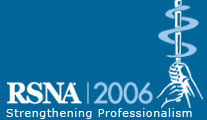
Abstract Archives of the RSNA, 2006
SSC08-08
Dual Source CT Cardiac Imaging: Initial Experience
Scientific Papers
Presented on November 27, 2006
Presented as part of SSC08: ISP: Cardiac (CT)
Thorsten Ralph Christopher Johnson MD, Presenter: Nothing to Disclose
Konstantin Nikolaou MD, Abstract Co-Author: Nothing to Disclose
Bernd Juergen Wintersperger MD, Abstract Co-Author: Nothing to Disclose
Sonja Buhmann, Abstract Co-Author: Nothing to Disclose
Andreas Knez MD, Abstract Co-Author: Nothing to Disclose
Christoph Richard Becker MD, Abstract Co-Author: Nothing to Disclose
Maximilian Ferdinand Reiser MD, Abstract Co-Author: Nothing to Disclose
et al, Abstract Co-Author: Nothing to Disclose
To assess the relation of heart rate and image quality in the depiction of coronary arteries, heart valves and myocardium on a dual source CT system (DSCT).
Coronary CT angiography was performed on a DSCT (Somatom Definition, Siemens) with high concentration contrast media (Iopromide, Ultravist 370, Schering) in 24 Patients with heart rates between 44 and 92 beats per minute. Tube voltage was 120 kV for both tubes, current 560 mA with tube current modulation, gantry rotation time 0.330 seconds and pitch 0.2 – 0.43 adapted to the heart rate. The volume of contrast material (370 mg I / ml) was adapted to the body weight with 1.25 ml / kg. 1 mm axial images were reconstructed for the whole cardiac cycle in 10% steps. Two readers independently assessed the image quality with regard to the diagnostic evaluation of right and left coronary artery, heart valves and left ventricular myocardium for the assessment of vessel wall changes, coronary stenoses, valve morphology and function and ventricular function on a three point grading scale (1=no artifacts; 2=motion artifacts, but diagnostic; 3=non-diagnostic). Additionally, radiation exposure in equivalent dose was calculated from previous phantom measurements.
Image quality was diagnostic in all cases. The image quality ratings at the optimal reconstruction interval were 1.24 ± 0.42 for the right and 1.09 ± 0.27 for the left coronary artery. A reconstruction of diagnostic systolic and diastolic images is possible for a wide range of heart rates. Both readers also rated the depiction of heart valves and myocardium as sufficient for functional evaluation in all patients. Calculated radiation exposure was 9.21 mSv on average.
Dual Source CT offers very robust diagnostic image quality in a wide range of heart rates. The high temporal resolution now also make a functional evaluation of heart valves and myocardium possible. The reliable diagnostic image quality makes it possible to narrow the pulsing windows to further cut down radiation exposure.
Dual Source CT provides diagnostic image quality of coronary angiography in a wide range of heart rates, making it a reliable diagnostic tool for all patients.
Johnson, T,
Nikolaou, K,
Wintersperger, B,
Buhmann, S,
Knez, A,
Becker, C,
Reiser, M,
et al, ,
Dual Source CT Cardiac Imaging: Initial Experience. Radiological Society of North America 2006 Scientific Assembly and Annual Meeting, November 26 - December 1, 2006 ,Chicago IL.
http://archive.rsna.org/2006/4433902.html

